You’re cruising down the highway, the sun glaring through the windshield, and you squint, struggling to see. It’s not just annoying; it’s downright dangerous. You wonder, “Could polarized sunglasses be the game-changer?” Yes, polarized sunglasses are good for driving.
Think of polarized lenses as your eyes’ bouncers. They keep out the riffraff—those pesky, blinding rays—so you can focus on what matters: the road.
We’ll get into the science, sure, but we’ll break it down so it’s as easy to understand as why you shouldn’t text and drive.
So, if you’re sick of squinting, gripping the wheel, and praying you don’t miss a turn signal because the sun decided to have a shining moment, stick around. You won’t regret it.
Are polarized sunglasses good for driving? Detailed Explanation
Yes, polarized sunglasses are generally better for driving, and here’s why.
The Pros: Your Drive Just Got an Upgrade
Sharper Vision and Vivid Colors:
With polarized lenses, the world looks like it’s in 4K resolution. You’ll notice enhanced colors and sharper vision, making it easier to spot road signs or potential hazards.
Goodbye, Annoying Glare:
You wouldn’t have to squint every time the sun hit your face or a car’s headlights flashed. Polarized lenses act like a shield, blocking out those irritating glares.
Eyes on Chill Mode:
Ever feel like your eyes are working overtime while driving? Polarized lenses reduce eye strain, making your eyes feel as relaxed as you do when sinking into a comfy couch.
Focused and Alert:
Less glare and eye strain mean you can concentrate better on the road. It’s like having a co-pilot who keeps all distractions at bay.
The Cons: A Few Speed Bumps
Flat World Syndrome:
One downside is that polarized lenses can make the world look a bit two-dimensional, affecting your depth perception. It’s not a deal-breaker but something to be aware of.
Not Night Owls:
These lenses are not the best companions for night driving or in low-light conditions. They can make an already dim environment appear even darker.
Dashboard Drama:
If your car has a digital dashboard, polarized lenses might make it hard to read. It’s like trying to read a text message with sunglasses on—not the best idea.
Extra Safety Tips
Clean Windows and Regular Eye Tests:
Keeping your windows clean and getting regular eye tests are as essential as choosing the right sunglasses. It’s basic car and eye maintenance that can make a big difference.
Mind the Lights and Your Energy Levels:
Knowing how to use your car lights and not driving when tired are also crucial. It’s like having good table manners; it just makes everything more pleasant and safer.
Lens Colors and Timing
Color Choices:
Picking the right lens color can be as crucial as choosing the right shoes for a hike. Some colors offer better contrast and are more suited for different lighting conditions.
When driving in bright sunlight, grey or black lenses are your go-to for reducing glare and making the road ahead clearer.
For overcast driving conditions, brown or amber lenses can help cut through the fog or mist, enhancing road visibility.
Navigating the roads during the golden hour? Green or gray lenses will absorb distracting horizontal rays while keeping the scenic colors true to life.
If you’re driving in conditions where contrast is low, like dawn or dusk, opt for brown, amber, or rose-copper lenses to make road signs and obstacles more distinct.
Avoid light-colored lenses like light green, light blue, pink, or red when driving, as they can interfere with your ability to accurately see red traffic lights. Ill-fitting sunglasses can also be a driving hazard.
Watch the Clock:
The sun can play tricks on you, going from bright to setting in minutes. Being aware of these changes can help you decide when it’s time to take off those shades.
For folks like drivers, outdoor adventurers, or anyone dealing with light-sensitive issues like migraines or photophobia, these sunglasses are a real boon. Why? Because they amp up your visual game, especially when you’re battling the glare on sunny days.
In a nutshell, polarized sunglasses offer a host of benefits that can make your driving experience safer and more comfortable. But they’re not without their quirks. As long as you’re aware of their limitations and take additional precautions, you’re setting yourself up for a smoother, safer ride.
Are Polarized Sunglasses Better for Driving?
Driving is an experience that demands clear vision and utmost attention. While the unique aspect of polarized sunglasses lies in their ability to filter out horizontal glare, their overall benefits extend beyond just that.
From enhancing visual clarity in bright sunlight to reducing eye strain during prolonged drives, polarized lenses prove to be a valuable companion on the road. If you’re wondering about the differences between polarized and non-polarized sunglasses, we have a detailed comparison.
However, like all things, they come with their set of limitations, especially in low-light conditions.



